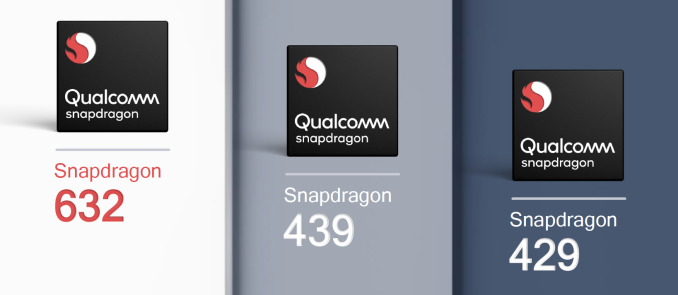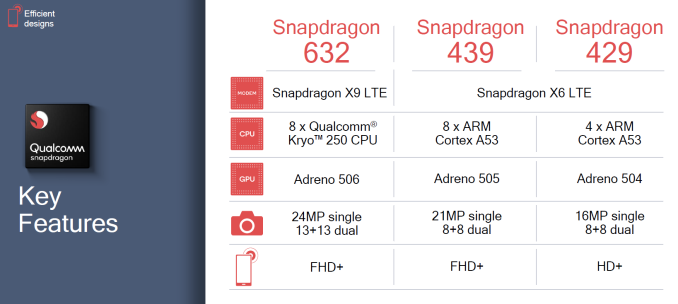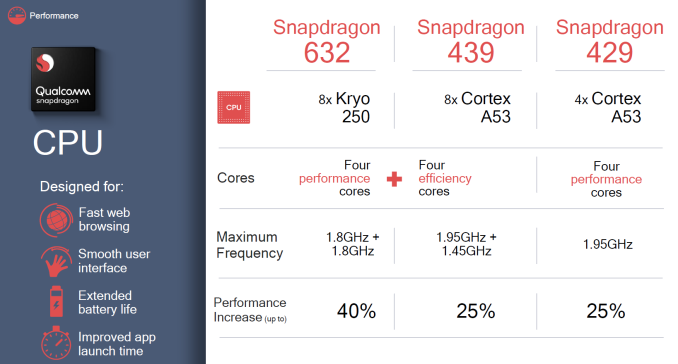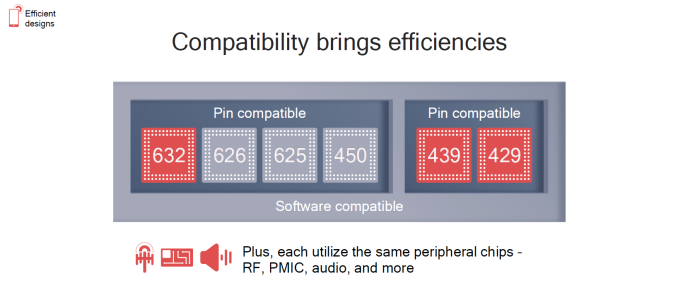Qualcomm Announces Snapdragon 632, 439 and 429 - Expanding the Low-Mid-tier
by Andrei Frumusanu on June 26, 2018 9:00 PM EST
A month ago we saw Qualcomm release a new “upper mid-range” SoC with the announcement of the Snapdragon 710 – the emphasis was on the fact that this was a new market tier aiming slightly below the top-tier flagship chipsets. Today, we’re seeing Qualcomm expand the traditional mid-tier and also what can be considered the low-end for smartphone devices. The Snapdragon 439 and 429 follow in the footsteps of the 435 and 425 and bring FinFET to the low-end; the Snapdragon 632 is more akin to the Snapdragon 652 as it’s now the first time we see big cores brought down to the lower mid-tier successor to the Snapdragon 630.
| New 2018 Mid & Low-End Snadpragons | ||||
| SoC | Snapdragon 632 | Snapdragon 439 | Snapdragon 429 | |
| CPU | 4x Kryo 250 (CA73) @ 1.8GHz 4x Kryo 250 (CA53) @ 1.8GHz |
4x A53 @ 1.95GHz 4x A53 @ 1.45 GHz |
4x A53 @ 1.95 | |
| GPU | Adreno 506 | Adreno 505 | Adreno 504 | |
| Modem | "X9 LTE" Cat. 7/13 300Mbps DL 150Mbps UL 4x10MHz C.A. (DL & 2CA UL) |
"X6 LTE" Cat. 4/5 150Mbps DL 75Mbps UL 2x10MHz C.A. (DL) |
||
| Camera/ISP | Dual ISP 24MP / 13+13MP |
Dual ISP 21MP / 8+8MP |
Dual ISP 16MP / 8+8MP |
|
| Mfc. Process | 14nm FinFET | 12nm FinFET | ||
Starting off with the Snapdragon 632, the new SoC is positioned as a successor to the Snapdragon 630. The 600 series suffered from quite a bit of naming confusion as we saw very large performance differences between the 65x and 66x series and the lower numbered ones such as the Snapdragon 630, 615 and 617 – this was largely due to the fact that the lower 600 series SoCs were missing the processing power of larger “big” CPU microarchitecture cores, while the 650 and up were effectively positioned as more expensive tiers.
The Snapdragon 632 now continues this lower-tiered positioning within the 600 series, but brings for the first time the performance benefit of big cores to this price segment. For these big cores we find 4x Kryo 250s running at up to 1.8GHz. Qualcomm didn’t confirm what CPU core this is based on, but looking at the CPUID of an unannounced device it matches the Cortex A72 and this would also make sense given the lower Kryo 2xx naming scheme. Qualcomm reached back confirming these are Cortex A73s. The big cores are paired with another 4x Kryo 250s – but again we’re effectively talking about Cortex A53 cores as the little cores in the efficiency cluster.
Meanwhile the Snapdragon 439 and 429 are direct successors to the 435 and 425. Like the S435, the S439 is a 8x A53 setup with a performance cluster going up to 1.95GHz while the second efficiency cluster goes up to 1.45GHz. The S429 is a simple single-cluster with 4x Cortex A53’s up to 1.95GHz and comes with a more updated Adreno 504 over the 425’s older Adreno 308, with the largest quoted performance improvement of up to 50%.
One of the most important characteristics of these new low-end SoCs is however that they’re manufactured on FinFET nodes – Qualcomm didn’t specify exactly the foundry or exact node but we’re likely talking about 14LPP or a 16FF variant, with the possibility of Qualcomm also third-sourcing these from UMC as well. Qualcomm reveals on its website the 632 is 14nm which likely points to Samsung 14LPP, and the 439 and 429 are listed as 12nm which points out to 12FFC from TSMC. This marks a generational shift as we see Qualcomm effectively have completed a total transition to FinFET products across its whole mobile SoC product line.
A large commercial advantage of the new chips is their design compatibility; the Snapdragon 632, 439, 429 are software compatible with each other and with the existing 626, 625 and 450 platforms. Furthermore the 632 is pin compatible with the 626, 625 and 450, and the 439 and 429 are pin compatible with each other. The software compatibility allows for a smaller resource investment on the part of OEMs and an accelerated time-to-market for devices. In particular, what seems to be very interesting here is the 632 being pin compatible with several older chips – It would be great to see OEMs be able to release quick refreshes of their devices with the new chip given that it’ll bring large performance improvements thanks to the new big CPU cores.
Overall the new mid- and low-end Snapdragons bring a generational improvement thanks to Qualcomm’s total switch to FinFET nodes across all of its line-up. The new SoC platforms are quoted be used in commercial devices released in the second half of 2018, which essentially means very soon.




















33 Comments
View All Comments
kpb321 - Tuesday, June 26, 2018 - link
Something seems off on the 632. The big/LITTLE that AnandTech describes would make sense but the slide call it Kyro 250 X8 which would seem to indicate the same processor for the performance and efficiency cores but with the same max clock speed it seems hard to have a performance and efficiency versions of the same core. The true big cores in the 632 would be nice as the 650 series always seemed fairly rare in phones but it makes me wonder what room is left for the recently announced 700 series.bubblyboo - Tuesday, June 26, 2018 - link
XDA's article says A73 and A53 on the 632. Can't find anyone else that backs up that info though. The Snapdragon 636 released recently does have the A73/A53 combo at least.shabby - Tuesday, June 26, 2018 - link
Those a53 cores need to die in a fire quick, you can have a 100 of them and the phone will still be slow.bubblyboo - Tuesday, June 26, 2018 - link
They're fine as LITTLE cores, but the 8xA53 config is getting quite annoying.Ratman6161 - Wednesday, June 27, 2018 - link
Depends on what you are looking for. For my wife, who has little need for processing power, I've been looking at the Motorola G5s Plus as a "good enough" cheapish phone. But take a look at this similar article from Feb 2016: https://www.anandtech.com/show/10030/qualcomm-anno...The "new" 439 looks to be pretty close to just a rebranding of the 625 used in the Motorola phones. So if the 625 was "good enough" now she might be able to move downscale even further to the "low end" which is essentially the same as the previous mid-range.
leo_sk - Wednesday, June 27, 2018 - link
Maybe the 710 series will feature better gpu and slightly better cpu due better node, along with the ai features , while 800 series will have best of everything, provided 1000 series doeasnt bring anything drasticphoenix_rizzen - Wednesday, June 27, 2018 - link
It's the same with the SD636. It lists "8x Kryo 260", but it's split up into two clusters, and benchmarks and analysis of that one shows a proper big.LITTLE configuration.Qualcomm has gone off the deep end with their naming scheme this year. The 600-series is both low-end and mid-range. The Kryo 260 is both a big CPU (A72) and a LITTLE CPU (A53). A bunch of other names are overloaded too.
And now they have a 632 (lower than the 636) with a big.LITTLE setup that's possibly as good as/better than a 650/660.
The whole 600-series of SoCs is a cluster-f of naming.
serendip - Thursday, June 28, 2018 - link
Not to mention the huge differences in GPU and LTE modems between 6xx SoCs. I think they're in a transition period now so 6xx will be the low-midrange with similar GPUs and modems. The 7xx will take over from the 65x and 660 with near-flagship components. 8xx will be flagship mobile parts while 1xxx will be laptop grade.serendip - Thursday, June 28, 2018 - link
Their core naming is a total mess though. Kryo Gold, Silver, Copper, Rusted Iron, is Qualcomm trying to be Intel? Just stick to ARM core naming.0iron - Tuesday, June 26, 2018 - link
"it’s now the first time we see big cores brought down to the lower mid-tier successor to the Snapdragon 630"So, Snapdragon 636 belong to which category?